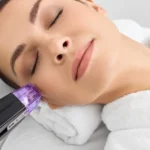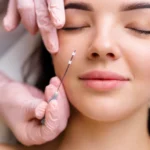Table of Contents
Looking for a solution to transform uneven skin texture and dull tone? Chemical peels offer powerful skin rejuvenation by removing damaged outer layers to reveal fresher, healthier skin beneath.
This guide explains how chemical peels improve both texture and tone, explores different treatment strengths, and highlights the specialized options available at Absolute Wellness and Aesthetics.
You’ll discover exactly what to expect before, during, and after your procedure—including recovery times and results—helping you determine if chemical peels in Newnan, GA are the right choice for your skincare concerns.
Understanding Chemical Peels
A chemical peel is a procedure that involves applying a chemical solution to the skin. It causes the top layers to exfoliate and eventually peel off. This controlled process stimulates the skin’s natural healing response, promoting cell turnover and collagen production. The expected result is smoother skin with enhanced texture and a more even tone.
How Do Chemical Peels Work for Skin Texture?
Chemical peels for skin texture work through several mechanisms. They dissolve the bonds found between dead skin cells. This action helps remove rough, outer layers of the skin. The exfoliation effect reveals a smoother skin surface beneath.
Additionally, chemical peels can stimulate collagen and elastin production. These two proteins enhance the skin’s structure and resilience over time. Chemical peels may also reduce the appearance of shallow acne scars. Lastly, chemical peels are effective in minimizing pore size, giving patients a refined and smoother complexion.
How Do Chemical Peels Work for Skin Tone?
Chemical peels address several concerns to improve skin tone. These specialized formulations target hyperpigmentation as they remove cells that contain excess melanin. The outcome? A more even skin tone.
Chemical peel treatments also help to enhance blood circulation. This contributes to a healthier and more radiant appearance. Chemical peels also encourage a more uniform cell turnover, helping to maintain consistent pigmentation across the skin.
Types of Chemical Peels
Different types of peels offer varying levels of treatment depth and results:
Light Peels
Light peels use mild acids like glycolic, lactic, or salicylic to gently exfoliate the outermost layer of skin. These peels offer subtle improvements with minimal downtime, making them ideal for maintenance treatments.
Chemical peel benefits at this level include:
- Improved skin brightness and texture
- Mild reduction in fine lines
- Clearing of minor blemishes and discoloration
- Minimal downtime, often called “lunchtime peels”
Medium-Depth Peels
These peels penetrate to the middle layers of skin using agents like trichloroacetic acid (TCA) or Jessner’s solution. Medium peels address more significant concerns and provide more dramatic results.
Benefits include:
- Significant improvement in sun damage and pigmentation
- Visible reduction in fine lines and moderate wrinkles
- Improvement in shallow acne scars
- Longer-lasting results than light peels
Deep Peels
Deep peels reach the lower dermal layers using stronger solutions like phenol. These treatments provide the most dramatic results but require longer recovery time.
Benefits include:
- Dramatic improvement in deep wrinkles and severe sun damage
- Significant tightening effect
- Long-lasting results
- Potential for significant improvement in deeper scars
The Science Behind Results
Texture Improvement
Exfoliation for smoother skin is the primary mechanism of all chemical peels. As the procedure eliminates the buildup of dead skin cells on the surface, the peels reveal the fresher, smoother skin beneath. This process also triggers:
- Accelerated cell turnover, bringing newer cells to the surface faster
- Stimulation of dermal proteins that provide structure to the skin
- Reduction in textural irregularities from scars or sun damage
- Smoothing of detectable fine lines and wrinkles by promoting new collagen formation
Tone Enhancement
Uneven skin tone—including hyperpigmentation, redness, and dullness—responds well to chemical peels through:
- Removal of pigmented cells containing excess melanin
- Regulation of melanin production in deeper layers
- Enhanced circulation bringing nutrients and oxygen to skin cells
- More uniform distribution of melanin throughout the skin
The Chemical Peel Process
Preparation
Proper preparation ensures optimal results and minimal complications:
- Consultation with a skincare provider can help determine the appropriate peel: A thorough consultation allows a licensed professional to properly assess your skin type, cosmetic concerns, and overall health.
- Possible pre-treatment with retinoids or hydroquinone for certain skin types: Some chemical peel patients have darker skin tones and are prone to hyperpigmentation. In such cases, pre-treatment with topical products such as retinoids or hydroquinone may be recommended.
- Avoiding sun exposure before the procedure: It’s essential to avoid direct sun exposure for at least 1 – 2 weeks prior to your peel. This is because sunburned or tanned skin may increase sensitivity. Moreover, it will heighten the risk of adverse reactions.
- Discontinuing certain skincare products temporarily: It is likely that your provider advise you to stop using exfoliants, alpha hydroxy acids (AHAs), beta hydroxy acids (BHAs), retinoids, and other potentially irritating products.
During the Procedure
The application process typically follows these steps:
- Thorough cleansing of the skin: The skin needs to be cleansed meticulously to remove any dirt, oil, or makeup. This step ensures that the chemical solution can penetrate evenly and effectively.
- Application of a protective barrier around sensitive areas: Petroleum jelly or other occlusive ointment is applied to sensitive areas. These may include the corners of the eyes, nostrils, and lips.
- Application of the chemical solution: The chosen chemical peel is applied evenly across the treatment area. Depending on the type of peel, the application might produce a tingling, stinging, or warm sensation.
- Monitoring of the skin’s response: Throughout the treatment, your provider will closely observe how the skin reacts. They may even adjust the timing or intensity of the chemical peel.
Recovery and Aftercare
Post-peel care is necessary for optimal healing and results:
- Gentle cleansing, moisturizing, and strict sun protection
- Allowing skin to peel naturally without forcing or picking
- Avoiding makeup until peeling is complete (for medium and deep peels)
- Using recommended post-peel products
- Maintaining sun protection to preserve results
Ideal Candidates for Chemical Peels
Chemical peel benefits can address various concerns for many skin types, including:
- Sun damage or photoaging
- Uneven pigmentation (melasma, post-inflammatory hyperpigmentation)
- Acne or acne scarring
- Fine lines and wrinkles
- Rough texture or dull skin tone
- Certain types of superficial scarring
However, not everyone is a suitable candidate for all types of chemical peels. Factors such as skin type, color, and specific concerns determine which peel is most appropriate. People with darker skin tones need specialized care as they pose a higher risk of post-inflammatory hyperpigmentation.
Enhancing Results with Proper Skincare
Chemical peels for skin texture work best when incorporated into a comprehensive skincare regimen:
- Daily use of broad-spectrum sunscreen
- Regular use of antioxidants like vitamin C
- Retinoids for maintaining cell turnover between peels
- Hydrating ingredients like hyaluronic acid and ceramides
- Professional guidance on product selection and usage
Potential Side Effects and Considerations
While chemical peels are generally safe when performed by qualified professionals, potential side effects include:
- Redness and irritation (expected and temporary)
- Dryness and flaking (part of the process)
- Temporary darkening or lightening of the skin
- Sensitivity to sunlight
- In rare cases: scarring, infection, or persistent redness
These risks increase with deeper peels but can be minimized with proper patient selection, preparation, and aftercare.
Chemical Peels at Absolute Wellness and Aesthetics
Absolute Wellness and Aesthetics provides patients with multiple options for individualized facial treatments using chemical solutions such as glycolic, salicylic, lactic, and trichloroacetic acids that give you healthier, more radiant skin on the face.
Our skin resurfacing treatments help to decrease skin flaws including wrinkles, fine lines, scars, uneven patches, hyperpigmentation issues, and more. Chemical peels clear away dead or damaged skin cells using an individualized solution on your skin, which causes the surface layer to peel off. As your skin heals and begins to rejuvenate and repair itself, you’ll notice a clearer, smoother complexion.
Experience the glow! Schedule your chemical peel treatment now.
Frequently Asked Questions
How often should I get a chemical peel for best results?
Light peels can be done monthly, medium peels every 3-6 months, and deep peels typically once a year or less.
Are chemical peels painful?
Light peels cause minimal discomfort (often just a tingling sensation), while medium and deep peels may require numbing cream or Pro-Nox for comfort.
How long will my skin peel after a chemical peel treatment?
Peeling typically lasts 3-5 days for light peels, 5-7 days for medium peels, and up to 14 days for deep peels.
Can I wear makeup after getting a chemical peel?
You should avoid makeup for 24-48 hours after a light peel and longer (5-7 days) after medium or deep peels.
Are chemical peels safe for darker skin tones?
Light peels using certain acids like lactic or mandelic acid are generally safe for darker skin tones when performed by experienced professionals who can customize the treatment to prevent hyperpigmentation.







